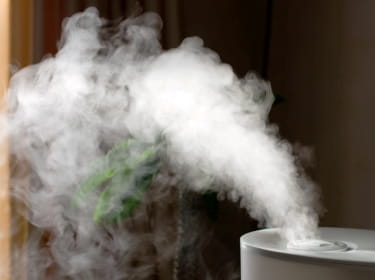Vaporizer Medicine: Dangerous to Swallow

The Bottom Line
Vaporizers can add moisture and medication to the air. This can help people who have colds, flu, or allergies. However, medicated vaporizer liquids are poisonous to swallow.

How do vaporizers work?
People with conditions like colds, flu, allergies, or dry skin can be made more comfortable by adding moisture to the air in their homes. There are 2 main ways to do this. Cool-mist humidifiers use ultrasonic vibrations or a rapidly spinning disc to create tiny droplets of water that are then propelled into the air. Steam vaporizers (warm-mist humidifiers) heat water and send the steam into the air.What liquids can you safely vaporize when you’re sick?
The most important liquid in any vaporizer is water. There are products specifically designed to be added to the water in steam vaporizers. These products are intended to increase the comfort provided by the steam. There are many different kinds and brands of these medicated solutions (one well-known brand is Vicks VapoSteam). The most common active ingredient in these products is camphor dissolved in ethanol, which is intended to relieve coughing.Are vaporizers safe for babies and small children?
Small children with cold or flu symptoms are too young to take cough and cold medicines. Hot steam vaporizers are sometimes suggested for children at least 2 years of age with stuffy noses or congestion. Steam vaporizers present a risk of burns if a child gets too close to the vaporizer or spills the hot water, so always place the vaporizer in a safe and stable location.Is vaporizer liquid poisonous?
Once the small amount of vaporizer medication has been added to the water in a vaporizer, toxicity is unlikely. However, the undiluted product is potentially poisonous, and camphor is its most dangerous ingredient. Camphor is absorbed into the body quickly after it is swallowed. Initial symptoms can include mouth and throat irritation, nausea, vomiting, and abdominal pain. The greatest danger presented by camphor is seizures, which might be the first symptom experienced. The ethanol in a vaporizer medication can cause drowsiness, loss of balance, and other symptoms of drunkenness.My child ingested vaporizer liquid. What should I do?
If someone swallows a vaporizer medication, use the webPOISONCONTROL online tool for guidance or call Poison Control right away at 1-800-222-1222. The webPOISONCONTROL tool or the poison specialist will tell you exactly what to do. Often, watching the person closely at home will be enough. Sometimes, a trip to the emergency room will be needed. If so, Poison Control will call the emergency room to provide treatment advice.Serkalem Mekonnen, RN, BSN, MPH
Certified Specialist in Poison Information
Revised William G. Troutman, PharmD
Professor of Pharmacy Emeritus
Poison Control Media Information
Did you find this page helpful? If so, we need your support. Poison Control is in constant competition with misinformation online. Links to www.poison.org or our webPOISONCONTROL triage tool from other websites and blogs help internet searchers quickly find accurate information and Poison Control’s contact information in an emergency. If you use the content from this page, please provide attribution via a link back to this page, www.poison.org, or https://triage.webpoisoncontrol.org/#!/exclusions. By doing so, you could save a life. Thank you!
Poisoned?
Call 1-800-222-1222 or
Prevention Tips
- Read the vaporizer medication instructions completely before using it.
- Always close the vaporizer medication container tightly after use.
- Keep the vaporizer away from children's reach.
- Be especially cautious when using steam vaporizers because of the risk of burns.
- Clean the vaporizer carefully so that mold and bacteria won't grow in it. The directions will tell you how.
This Really Happened
A caregiver accidentally gave a 10-month-old boy liquid vaporizer medicine instead of cold medicine. The vaporizer liquid contained camphor. The boy became very drowsy and was taken to an emergency room. The boy was breathing very fast and his pupils were larger than normal. Blood tests were abnormal and showed problems with his liver. The boy was admitted to the intensive care unit. By morning, he was awake and acting normal. He was sent home with his family and was to be seen by his pediatrician.For More Information
Humidifiers: ease skin, breathing symptoms. Mayo Clinic. June 21, 2023. Accessed July 2, 2024.
References
Vicks VapoSteam. Kaz, USA. Revised April 2023. Accessed July 2, 2024.
Poisoned?
Call 1-800-222-1222 or
Prevention Tips
- Read the vaporizer medication instructions completely before using it.
- Always close the vaporizer medication container tightly after use.
- Keep the vaporizer away from children's reach.
- Be especially cautious when using steam vaporizers because of the risk of burns.
- Clean the vaporizer carefully so that mold and bacteria won't grow in it. The directions will tell you how.
